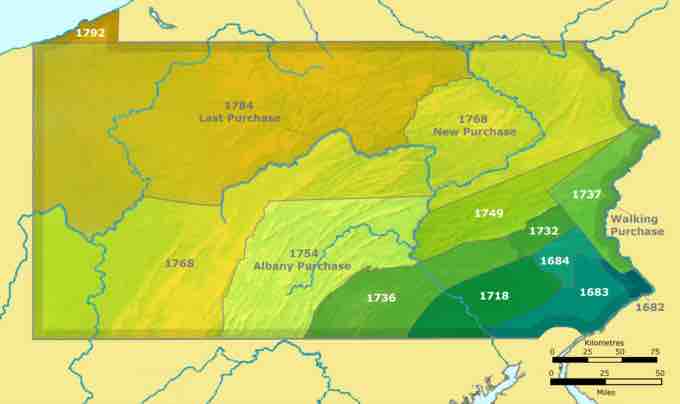The European-descendant settlers in the Americas were eager to expand their reach, develop farming and settlements in new areas, and satisfy their hunger for land. The newly established US national government initially sought to purchase land from American Indians by treaties, but states and settlers were frequently at odds with this policy. According to George Washington:
Whereas it hath at this time become peculiarly necessary to warn the citizens of the United States against a violation of the treaties.... I do by these presents require, all officers of the United States, as well civil as military, and all other citizens and inhabitants thereof, to govern themselves according to the treaties and act aforesaid, as they will answer the contrary at their peril.
Treaty of Fort Stanwix
The Treaty of Fort Stanwix was signed in New York in October 1784 between the US government and the indigenous peoples of the land they now occupied. The treaty served as a supposed peace treaty between the Iroquois and the Americans, yet it effectively procured more land from the American Indians and into the hands of the US government. Rather than secure peace, the Treaty helped set the stage for the next round of hostilities between American Indians and British colonists along the Ohio River, and this would culminate in Lord Dunmore's War.
In this treaty, the Iroquois Confederacy ceded all claims to the Ohio territory, a strip of land along the Niagara River, and all land west of the mouth of Buffalo Creek. In Pennsylvania, the land acquired in this treaty is known as the "Last Purchase." The Six Nations council at Buffalo Creek refused to ratify the treaty, stating its delegates did not have the power to give away such large tracts of land. It asked the US government to return the deeds and indemnify it for the land it had given away. The general American Indian confederacy also disavowed the treaty, as most members of the Six Nations did not live in the Ohio territory. Many of the Ohio Country American Indians (including the Shawnee, Mingo, and Delaware tribes) fully rejected the treaty.
At one time, historians believed the Treaty of Fort Stanwix was an example of Iroquois being forced to accept unreasonable cessions. However, since the late 20th century, historians have credited the Iroquois with high-level strategic thinking in terms of giving up little-used land to deflect English settlement away from their own, more valuable homeland.

Pennsylvania land purchases
A map showing land purchases from Native Americans in Pennsylvania (1682–1792).
Cultural Assimilation of American Indians
The cultural assimilation of American Indians was an assimilation effort by the United States to transform American Indian culture to European-American culture between the years of 1790 and 1920. With increased waves of immigration from Europe, there was growing public support among US citizens for education to encourage a standard set of cultural values and practices that the majority of citizens would hold in common. Education was viewed as the primary method in the acculturation process for minorities.
George Washington and Henry Knox were the first to propose cultural transformation of American Indians. A common sentiment held by many, including Washington and Knox, was the Eurocentric belief that American Indians were inferior to Europeans, or that they were personally equal but their society was inferior and "uncivilized." Stemming from this belief Washington advocated for so-called advancement of American Indian society and formulated a policy to encourage a "civilizing" process.
Americanization policies were based on the idea that when indigenous people learned US ("American") customs and values, they would be able to merge tribal traditions with American culture and peacefully join the majority of society. When the Indian Wars had concluded, in the late 19th and early 20th centuries, the government outlawed the practice of traditional religious ceremonies. It established American Indian boarding schools that children were required to attend. There they were forced to speak English, study standardized subjects, attend church, and leave tribal traditions behind.
Six-Point Plan
Washington developed a six-point plan for this assimilation process that included:
- Impartial justice toward American Indians
- Regulated buying of American Indian land
- Promotion of commerce
- Promotion of experiments to civilize or improve American Indian society
- Presidential authority to give presents
- Punishments for those who violated American Indian rights
The United States appointed agents, such as Benjamin Hawkins, to live among the American Indians and teach them how to live in accordance with European standards. The Civilization Fund Act of 1819 promoted this policy by providing funding to societies (mostly religious) who worked on American Indian "improvement." These societies encouraged the assimilation and Christianization of American Indians.